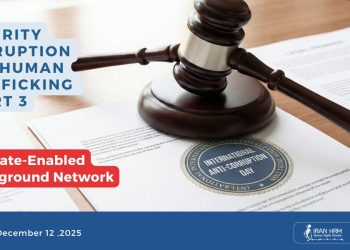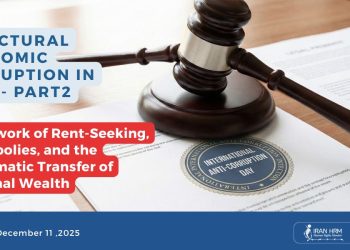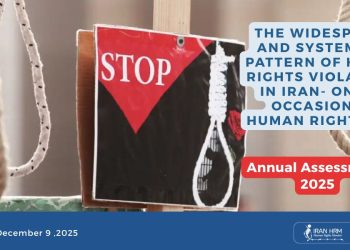On the International Day of the Child
In many countries around the world, the International Day of the Child is an occasion for celebration, play, and hope for a brighter future; a day when schools and families emphasize children’s rights, joy, and safety. But in Iran under the mullahs’ regime, this day carries a different meaning. The reality of life for millions of Iranian children is entangled with poverty, insecurity, discrimination, structural violence, and the denial of fundamental rights; an undeniable truth that exposes the deep gap between global standards and the daily experiences of children.
While the world celebrates, children in Iran remain trapped in cycles of execution, poverty, child marriage, and repression.
Right to Life: Execution of Juveniles and the State-Driven Policy of Violence
Iran is the only country that continues to carry out executions of individuals who were under the age of 18 at the time of the alleged offense. Mai Sato, the UN Special Rapporteur on the situation of human rights in Iran, has called for the immediate halt of these executions, and Michelle Bachelet, the UN High Commissioner for Human Rights, has likewise urged Iran to stop implementing such sentences without delay.
Multiple cases demonstrate this reality:
Fatemeh Saleh Behi, who was forced into marriage at 16 and later executed;
Samad Zahabi, sentenced to death at 17;
Mehdi Rajai, who was only 16 at the time of the incident;
and two teenagers from Shiraz whose birth certificates proved they were under 18 despite claims made by the judiciary.
Christof Heyns, the UN Special Rapporteur on extrajudicial executions, described these killings as “unlawful state executions.”
Even Article 91 of the Islamic Penal Code, ostensibly adopted to reduce juvenile executions, has in practice produced the opposite effect. The 2024 directive issued by the judiciary grants judges’ expansive authority to determine a juvenile’s maturity solely based on their own “judicial knowledge,” without referring cases to forensic experts—an instrument that enables, rather than restricts, death sentences.
Killing of Children during the 2022 Uprising: Organized Violence
During the nationwide uprising of 2022, violence against children reached a shocking scale. At least 70 children under 18 were killed because of direct fire by security forces. Amnesty International has documented the identities of 44:
39 boys aged 2 to 17, and 5 girls aged 6 to 17.
The pattern of killings demonstrates a deliberate policy aimed at instilling public fear.
34 children were shot in vital areas such as the head and chest.
Others died from close-range pellet fire or severe beatings.
- Kian Pirfalak, 9 – killed by direct fire inside his family’s car in Izeh; symbol of the “child-killing government.”
• Nika Shakarami, 16 – killed after arrest due to beatings and gunshot wounds; body buried secretly.
• Sarina Esmailzadeh, 16 – killed by multiple baton blows to the head in Karaj.
• Javad Pouzeh, 11 – shot in the back of the head returning from Friday prayers in Izeh.
• Samer Hashem-zahi, 17 (Zahedan) – among the victims of “Bloody Friday,” symbol of the organized killing of Baloch children.
These names represent only a small portion of dozens of children killed victims of the regime’s systematic use of lethal force against protesters, including minors.
Child Trafficking: The Most Extreme Form of Exploitation
Widespread poverty, addiction, and the absence of support networks have led to an increase in the sale of children in several cities across Iran. Child trafficking sometimes occurs even before birth, with families facing extreme poverty or addiction selling newborns for minimal amounts.
Trafficked children, especially those aged 8- 15; if unable to work, are exposed to severe exploitation or even the sale of their organs.
This phenomenon is the product of a structure that abandons vulnerable families without support and turns children into silent victims of economic and social collapse.
Poverty, Malnutrition, and Widespread Deprivation
Structural poverty in Iran has affected millions of children. Malnutrition in deprived provinces has become a chronic crisis. Domestic reports repeatedly note tens of thousands of malnourished children under age five, with numbers rising in impoverished regions.
Falling income, inflation, reduced access to food, and inability to purchase medicine have made children the first victims of the economic crisis, threatening their physical and cognitive development.
Right to Education: Dropouts, Unsafe Conditions, and Discrimination
The right to equal education for children in Iran faces extensive barriers.
Dilapidated infrastructure, overcrowded classrooms, dangerous heating equipment, and unsafe school buildings endanger the educational environment.
In some areas, families are forced to choose between sending their children to unsafe schools or allowing them to drop out.
Educational content shaped by ideological approaches and gender discrimination has further reduced educational quality and restricted children’s ability to grow freely.
Child Labor: From the Streets to the Cycle of Poverty, Exploitation, and Vulnerability
Child labour is one of the most widespread and structural manifestations of violations of children’s rights in Iran. Under Article 32 of the Convention on the Rights of the Child, states are obligated to protect children from all forms of economic exploitation and work that harms their health, education, or development.
Iran does not uphold these obligations.
Because of structural poverty, lack of social protection, and rising living costs, millions of children are forced to work to survive and support their families; in the streets, underground workshops, brick kilns, informal service jobs, and especially in the dangerous cycle of waste collection.
Many work long hours daily, without insurance, without oversight, and under severe physical and psychological risks.
The true scale of the crisis is evident even in limited official data.
One government report stated that in Tehran alone, thousands of child waste collectors were identified.
Experts note that official data is inaccurate, and in provinces such as Sistan–Baluchestan and Khorasan, the situation is described as catastrophic.
Child laborers are exposed to sexual abuse, street violence, and economic exploitation, clear violations of Article 34 of the Convention on the Rights of the Child.
Reports also indicate that exploitation networks target orphaned or homeless children and force them into sexual exploitation or bonded labor.
Another dimension is the use of children in drug trafficking networks; a direct violation of Article 33 of the Convention.
Children in impoverished regions are easily recruited by traffickers.
Some reports highlight a decreasing age of addiction, even among teenage girls; evidence of collapsing social protection systems.
In sum, child labor in Iran is not a marginal phenomenon but a national crisis trapping millions of children in a triad of violence, poverty, and exploitation.
Compound Discrimination Against Girls: Sexual Violence, Child Marriage, and Social Deprivation
Girls in Iran face multilayered discrimination: sexual violence, street labour, cultural restrictions, and child marriage.
Official data from the Statistical Center of Iran shows that in 2022,
25,900 marriages involving girls under age 15 were registered.
The annual average of marriages involving girls under 18 exceeds 135,000,
and around 1,700 involve girls under age 13.
The consequences are devastating:
- 1,392 infants were born to mothers under 15 (2022).
- 779 divorces involved girls under 15.
Child marriage leads to early pregnancy, school dropout, economic dependency, and severe psychological harm.
Child Porters, Undocumented Children, and Minority Children
In border regions, child porters (koulbars) face lethal dangers—from security force gunfire to falling from mountain paths or landmine explosions.
These children are the final victims of poverty, regional discrimination, and the absence of state protection.
Children without birth certificates or those born from unregistered marriages are denied basic rights such as education and healthcare.
Minority children in Baluchistan, Kurdistan, and Khuzestan endure systematic discrimination in education, social services, and security.
Global Condemnations and International Monitoring
International organizations have repeatedly accused Iran of violating its obligations toward children’s rights.
Amnesty International, in a detailed report, described:
- the killing of children during the 2022 uprising,
- arbitrary arrests,
- intimidation and threats against families,
as evidence of “unimaginable brutality and a systematic effort to conceal the crimes.”
UNICEF expressed “deep concern” over reports of children being killed, injured, or arrested during protests, and called for immediate protection of children from all forms of violence.
The agency echoed the UN Secretary-General’s demand to refrain from excessive use of force, calling attacks on schools and children “unacceptable.”
Save the Children, speaking at the UN Human Rights Council, urged:
- unequivocal condemnation of the killing and arrest of hundreds of children,
- and the creation of an independent, well-equipped investigative mechanism to examine violations against minors.
The organization stressed that the scale of violations exceeds common patterns and requires special international oversight.
Blocking International Oversight
By invoking its reservation to the Convention on the Rights of the Child, Iran has restricted the implementation of many of its international obligations.
Its refusal to join the Optional Protocol on a Communications Procedure has blocked children’s ability to submit direct complaints—an action that weakens international oversight and facilitates the continuation of violations.
Call to the International Community and Human Rights Bodies
- Request the UN Human Rights Council to establish an independent mechanism investigating juvenile executions and the killing of children.
• Extend and reinforce the mandate of the UN Special Rapporteur on human rights in Iran.
• Urge the Committee on the Rights of the Child to address child marriage as a priority and report to the General Assembly.
• Support emergency international programs targeting child malnutrition and poverty.
• Develop specialized protection systems for child laborers, trafficked children, and victims of exploitation.
• Mandate UNICEF and UNHCR to monitor undocumented children and secure their access to identity documentation and basic services.
• Encourage states to support Iran’s accession to the Optional Protocol on a Communications Procedure.
• Promote the reform of discriminatory laws and the elimination of structural violence against children.
Final Conclusion
The International Day of the Child in Iran, instead of being a celebration, highlights a painful reality endured by millions of children:
poverty, violence, discrimination, repression, and the denial of fundamental rights.
This report shows that the widespread violations of children’s rights in Iran stem from policies and structures that prioritize political interests over the rights and well-being of children.
Accountability, transparency, and international monitoring are essential prerequisites for any sustainable change.
The future of any society depends on how it treats its children; and in today’s Iran, this protection is more urgently needed than ever.







